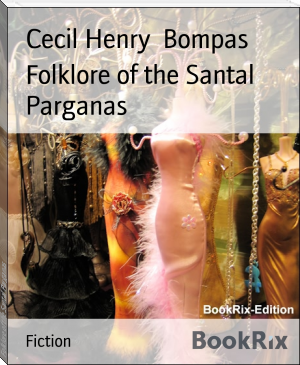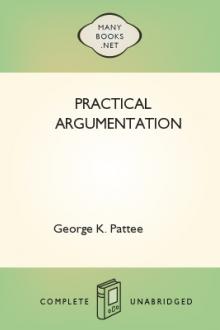Folklore of the Santal Parganas, Cecil Henry Bompas [sad books to read .TXT] 📗

- Author: Cecil Henry Bompas
Book online «Folklore of the Santal Parganas, Cecil Henry Bompas [sad books to read .TXT] 📗». Author Cecil Henry Bompas
The Santals are a Munda tribe, a branch of that aboriginal element
which probably entered India from the North East. At the present day
they inhabit the Eastern outskirts of the Chutia Nagpore plateau.
Originally hunters and dwellers in the jungle they are still but
indifferent agriculturists. Like the Mundas and Hos and other
representatives of the race, they are jovial in character, fond of
their rice beer, and ready to take a joke.
Their social organization is very complete; each village has its
headman or manjhi, with his assistant the paranik; the jogmanghi
is charged with the supervision of the morals of the young men and
women; the naeke is the village priest, the godet is the village
constable. Over a group of villages is the pargana or tribal chief. The
Santals are divided into exogamous septs--originally twelve in number,
and their social observances are complex, e.g. while some relations
treat each other with the greatest reserve, between others the utmost
freedom of intercourse is allowed.
Their religion is animistic, spirits (_bongas_) are everywhere around
them: the spirits of their ancestors, the spirit of the house, the
spirit dwelling in the patch of primeval forest preserved in each
village. Every hill tree and rock may have its spirit. These spirits
are propitiated by elaborate ceremonies and sacrifices which generally
terminate in dances, and the drinking of rice beer.
The Santal Parganas is a district 4800 sq. miles in area, lying
about 150 miles north of Calcutta, and was formed into a separate
administration after the Santals had risen in rebellion in 1856. The
Santals at present form about one-third of the population.
The stories and legends which are here translated have been collected
by the Rev. O. Bodding, D.D. of the Scandinavian Mission to the
Santals. To be perfectly sure that neither language nor ideas should in
any way be influenced by contact with a European mind he arranged for
most of them to be written out in Santali, principally by a Christian
convert named Sagram Murmu, at present living at Mohulpahari in the
Santal Parganas.
Santali is an agglutinative language of great regularity and complexity
but when the Santals come in contact with races speaking an Aryan
language it is apt to become corrupted with foreign idioms. The
language in which these stories have been written is beautifully
pure, and the purity of language may be accepted as an index that
the ideas have not been affected, as is often the case, by contact
with Europeans.
My translation though somewhat condensed is very literal, and the
stories have perhaps thereby an added interest as shewing the way in
which a very primitive people look at things. The Santals are great
story tellers; the old folk of the village gather the young people
round them in the evening and tell them stories, and the men when
watching the crops on the threshing floor will often sit up all night
telling stories.
There is however, no doubt that at the present time the knowledge of
these stories tends to die out. Under the peace which British rule
brings there is more intercourse between the different communities
and castes, a considerable, degree of assimilation takes place,
and old customs and traditions tend to be obliterated.
Several collections of Indian stories have been made, _e.g._ Stokes,
Indian Fairy Tales; Frere, Old Deccan Days; Day, Folk Tales of
Bengal; and Knowles' Folk Tales of Kashmir, and it will be seen
that all the stories in the present collection are by no means of
pure Santal origin. Incidents which form part of the common stock of
Indian folklore abound, and many of the stories professedly relate
to characters of various Hindu castes, others again deal with such
essentially Santal beliefs as the dealings of men and _bongas_.
The Rev. Dr. Campbell of Gobindpore published in 1891 a collection
of Santal Folk Tales. He gathered his material in the District of
Manbhum, and many of the stories are identical with those included in
the present volume. I have added as an appendix some stories which I
collected among the Hos of Singhbhum, a tribe closely related to the
Santals, and which the Asiatic Society of Bengal has kindly permitted
me to reprint here.
My task has been merely one of translation; it is due solely to Mr
Bodding's influence with, and intimate knowledge of, the people that
the stories have been committed to writing, and I have to thank him
for assistance and advice throughout my work of translation.
I have roughly classified the stories: in part 1 are stories of a
general character; part 2, stories relating to animals; in part 3,
stories which are scarcely folklore but are anecdotes relating to
Santal life; in Part 4, stories relating to the dealings of _bongas_
and men. In part 5, are some legends and traditions, and a few notes
relating to tribal customs. Part 6 contains illustrations of the
belief in witchcraft. I have had to omit a certain number of stories
as unsuited for publication.
H. Bompas. Table of Contents
PART I
Bajun and Jhore Anuwa and His Mother
III. Ledha and the Leopard
The Cruel Stepmother Karmu and Dharmu The Jealous StepmotherVII. The Pious Woman
VIII. The Wise Daughter-in-Law
The Oilman and His Sons The Girl Who Found Helpers How to Grow RichXII. The Changed Calf
XIII. The Koeri and the Barber
XIV. The Prince Who Acquired Wisdom
The Monkey BoyXVI. The Miser's Servant
XVII. Kuwar and the Rajahs Daughter
XVIII. The Laughing Fish
XIX. How the Cowherd Found a Bride
Kara and GujaXXI. The Magic Cow
XXII. Lita and His Animals
XXIII. The Boy Who Found His Father
XXIV. The Oilman's Bullock
XXV. How Sabai Grass Grew
XXVI. The Merchant's Son and the Rajah's Daughter
XXVII. The Flycatcher's Egg
XXVIII. The Wife Who Would Not Be Beaten
XXIX. Sahde Goala
XXX. The Rajah's Son and the Merchant's Son
XXXI. The Poor Widow
XXXII. The Monkey and the Girl
XXXIII. Ramai and the Animals
XXXIV. The Magic Bedstead
XXXV. The Ghormuhas
XXXVI. The Boy Who Learnt Magic
XXXVII. The Charitable Jogi
XXXVIII. Chote and Mote
XXXIX. The Daydreamer
The Extortionate SentryXLI. The Broken Friendship
XLII. A Story Told By a Hindoo
XLIII. The Raibar and the Leopard
XLIV. The Ungrateful Snake
XLV. The Tiger's Bride
XLVI. The Killing of the Tiger
XLVII. The Dream
XLVIII. The King of the Bhuyans
XLIX. The Foolish Sons
Kora and His Sister A Story on CasteLII. Tipi and Tepa
LIII. The Child With the Ears of the Ox
LIV. The Child Who Knew His Father
Jogeshwar's MarriageLVI. The Strong Man
LVII. The Rajah's Advice
LVIII. The Four Jogis
LIX. The Charitable Rajah
A Variant.--The Wandering RajaLXI. The Two Wives
LXII. Spanling and His Uncles
LXIII. The Silent Wife
LXIV. The Dumb Shepherd
LXV. The Good Daughter-in-Law
LXVI. The Rajah's Dream
LXVII. The Mongoose Boy
LXVIII. The Stolen Treasure
LXIX. Dukhu and His Bonga Wife
LXX. The Monkey Husband
LXXI. Lakhan and the Wild Buffaloes
LXXII. The Boy with the Stag
LXXIII. The Seven Brothers and the Bonga Girl
LXXIV. The Tiger's Foster Child
LXXV. The Caterpillar Boy
LXXVI. The Monkey Nursemaid
LXXVII. The Wife Who Could Not Keep a Secret
LXXVIII. Sit and Lakhan
LXXIX. The Rajah Who went to Heaven
LXXX. Seven Tricks and Single Trick
LXXXI. Fuljhari Rajah
LXXXII. The Corpse of the Rajah's Son
LXXXIII. The Sham Child
LXXXIV. The Sons of the Kherohuri-Rajah
LXXXV. The Dog Bride
LXXXVI. Wealth or Wisdom
LXXXVII. A Goala and the Cow
LXXXVIII. The Telltale Wife
LXXXIX. The Bridegroom Who Spoke in Riddles
The Lazy ManXCI. Another Lazy Man
XCII. The Widow's Son
XCIII. The Boy Who Was Changed Into a Dog
XCIV. Birluri and Birbanta
XCV. The Killing of the Rakhas
XCVI. The Children of the Vultures
XCVII. The Ferryman
XCVIII. Catching a Thief
XCIX. The Grasping Rajah
The Prince Who Would Not Marry The Prince Who Found Two WivesCII. The Unfaithful Wife
CIII. The Industrious Bride
CIV. The Boy and His Fate
The Messengers of DeathCVI. The Speaking Crab
CVII. The Leopard Outwitted
CVIII. The Wind and the Sun
CIX. The Coldest Season
PART II
The Jackal and the Crow
CXI. The Tiger Cub and the Calf
CXII. The Jackal and the Chickens
CXIII. The Jackal Punished
CXIV. The Tigers and the Cat
CXV. The Elephants and the Ants
CXVI. A Fox and His Wife
CXVII. The Jackal and the Crocodiles
CXVIII. The Bullfrog and the Crab
CXIX. The Hyena Outwitted
CXX. The Crow and the Egret
CXXI. The Jackal and the Hare
CXXII. The Brave Jackal
CXXIII. The Jackal and the Leopards
PART III
CXXIV. The Fool and His Dinner
CXXV. The Stingy Daughter
CXXVI. The Backwards and Forwards Dance
CXXVII. The Deaf Family
CXXVIII. The Father-in-Law's Visit
CXXIX. Ramai and Somai
CXXX. The Two Brothers
CXXXI. The Three Fools
CXXXII. The Cure For Laziness
CXXXIII. The Brahmin's Powers
CXXXIV. Ram's Wife
CXXXV. Palo
CXXXVI. The Women's Sacrifice
CXXXVII. The Thief's Son
CXXXVIII. The Divorce
CXXXIX. The Father and the Father-in-Law
CXL. The Reproof
CXLI. Enigmas
CXLII. The Too Particular Wife
CXLIII. The Paharia Socialists
CXLIV. How A Tiger Was Killed
CXLV. The Goala's Daughter
CXLVI. The Brahmin's Clothes
CXLVII. The Winning of the Bride
PART IV
CXLVIII. Marriage With Bongas
CXLIX. The Bonga Heaven
Lakhan and the BongaCLI. The House Bonga
CLII. The Sarsagun-Maiden
CLIII. The Schoolboy and the Bonga
CLIV. The Bonga's Cave
CLV. The Bonga's Victim
CLVI. Baijal and the Bonga
CLVII. Ramai and the Bonga
CLVIII. The Boundary Bonga
CLIX. The Bonga Exorcised
PART V
CLX. The Beginning of Things
CLXI. Chando and His Wife
CLXII. The Sikhar Rajah
CLXIII. The Origin of Tobacco
CLXIV. The Transmigration of Souls
CLXV. The Next World
CLXVI. After Death
CLXVII. Hares and Men
CLXVIII. A Legend
CLXIX. Pregnant Women
CLXX. The Influence of the Moon
CLXXI. Illegitimate Children
CLXXII. The Dead
CLXXIII. A Hunting Custom
Part VI
CLXXIV. Witchcraft
CLXXV. Of Dains and Ojhas
CLXXVI. Initiation Into Witchcraft
CLXXVII. Witch Craft
CLXXVIII. Witch Stories
CLXXIX. Witch Stories
CLXXX. Witch Stories
CLXXXI. The Two Witches
CLXXXII. The Sister-in-Law Who Was a Witch
CLXXXIII. Ramjit Bonga
CLXXXIV. The Herd Boy and the Witches
CLXXXV. The Man-Tiger
Glossary
Appendix
Part I.
In these stories there are many incidents which appear in stories
collected in other parts of India, though it is rather surprising
that so few of them appear elsewhere in their entirety. We have
however, instances of the husk myth, the youngest son who surpasses
his brother, the life of the ogre placed in some external object, the
jealous stepmother, the selection of a king by an elephant, the queen
whose husband is invariably killed on his wedding night, etc. etc.
Few of the old Indian stories found in the Kathâ Sarit Sâgara or the
Buddhist Birth stories appear in recognizable form in the present
collection.
Bajun and Jhore.
Once upon a time there were two brothers named Bajun and Jhore. Bajun
was married and one day his wife fell ill of fever. So, as he was
going ploughing, Bajun told Jhore to stay at home and cook the dinner
and he bade him put into the pot three measures of rice. Jhore stayed
at home and filled the pot with water and put it on to boil; then he
went to look for rice measures; there was only one in the house and
Jhore thought "My brother told me to put in three measures and if I
only put in one I shall get into trouble." So he went to a neighbour's
house and borrowed two more measures, and put them into the pot and
left them to boil. At noon Bajun came back from ploughing and found
Jhore stirring the pot and asked him whether the rice was ready. Jhore
made no answer, so Bajun took the spoon from him, saying "Let me feel
how it is getting on", but when he stirred with the spoon he heard a
rattling noise and when he looked into the pot he





Comments (0)